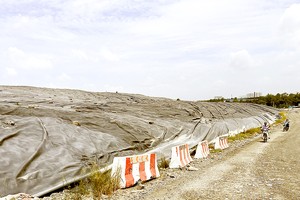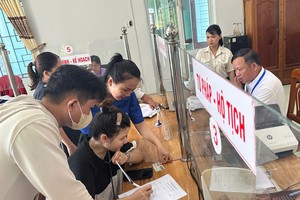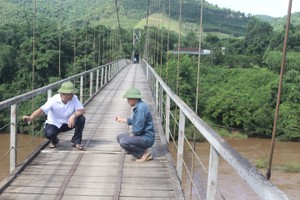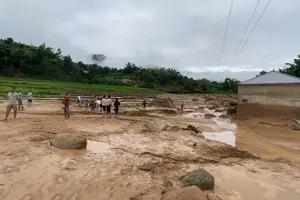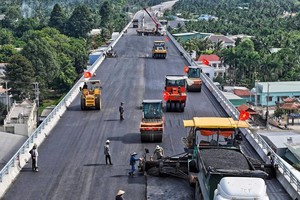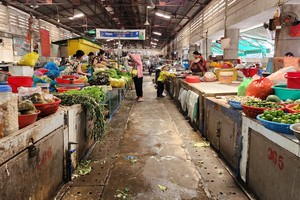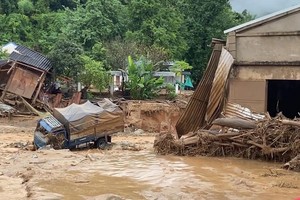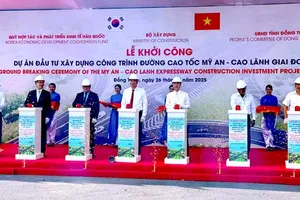During the past two years, prices of pepper has strongly climbed, urging farmers to rush to replace other crops by pepper. The fact that farmers chopped down perennial industrial trees to run after market prices has been destroying agricultural planning of the Central Highlands of Vietnam which will lead to unforeseen consequences.

Farmers in the Central Highlands provinces of Vietnam have cut off hundreds of hectares of coffee and rubber trees to grow pepper plants. Although massive cultivation of pepper contains many risks, farmers neglected warnings of local agricultural authorities.
Rubber trees become pepper poles
As seeing many households in the area gaining hundreds of millions of Vietnamese dong annually from growing pepper while the price of rubber has been dropping lower and lower (fresh rubber latex is currently bought at VND6,000 per kilogram), Lai Quoc Huy, a farmer in Tong Lia Village in Dak Lak Province’s Cu M’gar District, decided to clear his 3 hectares of rubber trees for cultivation of pepper plants. Last year, when the price of rubber latex fell to VND7,000 per kilogram, the amount of money earned from rubber trees was just enough for him to pay for workers and fertilizers. This year, he put more effort into his rubber trees with the hope that rubber price would rise again. Unfortunately, rubber price continues to drop, he is estimated to lose about VND5 million per hectares of rubber trees. Therefore, he cut the top of his rubber trees and used their trunks as poles for pepper plants. According to Mr. Huy’s calculation, as he has taken full advantage of rubber tree-trunks, he will only have to invest in about VND70 million per hectare for pepper saplings, fertilizers, and pesticides.
Le Van Hung, a farmer in Cu M’gar District’s Ea Kpam Commune, also chopped down his two hectares of rubber trees which are ready for harvest for cultivation of pepper.
‘Earnings from rubber latex are not enough to pay for workers. The current price of pepper is dozens of times higher than that of rubber so local farmers are no longer interested in rubber trees,’ he said.
He has grown 200 poles of pepper, hoping that pepper price will remain steady as present so that his earnings will be improved within the next two years.
According to Dao Van Mung, a farmer in Dak Sin Commune in Dak Nong Province’s Dak R’Lap District, who has just finished chopping off the top of his two hectares of rubber trees which are just old enough to produce latex, he gains around VND40 million annually from rubber trees. If excluded expenses for fertilizers and labor, his income remains at around VND10 million. With such amount of money, he cannot afford his family’s needs. He also keeps the rubber tree trunks to use as poles for pepper plants to reduce investment cost. As for young rubber trees, he keeps them to shade pepper plants.
Farmers in Dak Nong Province’s Dak Mil District also erased more than 65 hectares of rubber trees and most of them only cut the top of the tree and kept the tree trunks.
Pepper replaces coffee
Despite local authorities’ warnings, several farmers in Gia Lai Province are chopping down their coffee trees for pepper plants.
Le Huu Nguyen, a farmer in Ia Pal Commune in Chu Se District, destroyed his coffee farm to cultivate 550 pepper poles. He explained that each pepper pole yields an average production of 8 kilogram of pepper and a kilogram of pepper costs VND200,000. If his pepper plants grow healthily, his family will earn nearly VND900 million annually much higher than from growing coffee.
In Dak Lak Province, farmers have also rushed to replace coffee trees by pepper. Cu Sue Commune in Cu M’gar District is one of the places where most farmers have shifted to grow pepper. Within the past two years, nearly 20 hectares of coffee trees had been cleared and replaced by pepper plants.
A farmer in Cu Sue Commune said that if he destroyed his coffee farm for re-plantation, he would have to wait three years for coffee trees to mature and yield fruits while the price of coffee has been volatile and at low level for many years which means highest profit from coffee will be merely at around VND200 million annually. This year, he spent VND150 million to gamble in pepper plants, hoping that when his pepper plants are ready for harvest, pepper price will still be as steady as it is in recent years so that he can receive a profit of more than VND1 billion annually.
Unforeseen consequences
According to Mr. Pham Quang Muoi, head of the Department of Agriculture and Rural Development of Cu M’gar District, planting pepper on rubber land will affect the development and productivity of pepper as some areas are not suitable for pepper plants. In addition, nutrients in rubber land were degenerated. Massive cultivation of pepper will probably lead to overproduction in the near future.
Mr. Luong Van Tu, chairman of the Vietnam Coffee and Cocoa Association said that replacing coffee by other crops would cause immeasurable consequences to agriculture of the Central Highlands provinces. Hence, local agricultural officials should direct suitable cultivar structure for each area. Besides, farmers also should consider carefully before shifting to growing pepper.
Provincial agricultural departments have also warned farmers not to replace rubber and coffee trees by other crops.

